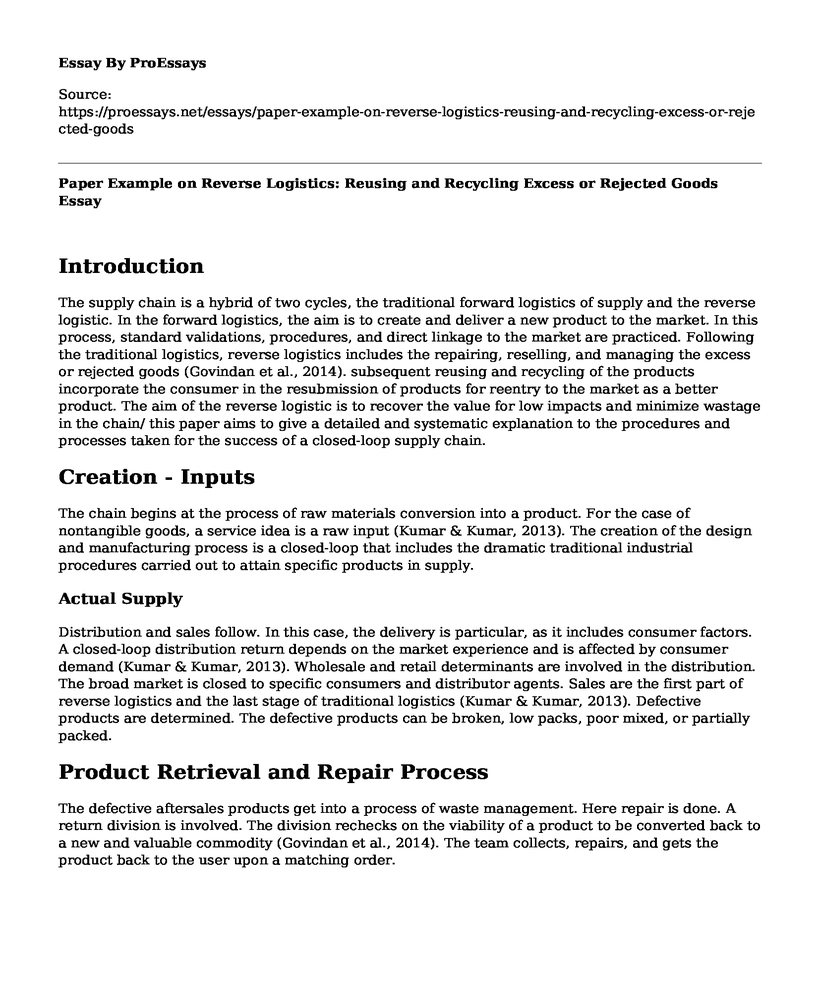Introduction
The supply chain is a hybrid of two cycles, the traditional forward logistics of supply and the reverse logistic. In the forward logistics, the aim is to create and deliver a new product to the market. In this process, standard validations, procedures, and direct linkage to the market are practiced. Following the traditional logistics, reverse logistics includes the repairing, reselling, and managing the excess or rejected goods (Govindan et al., 2014). subsequent reusing and recycling of the products incorporate the consumer in the resubmission of products for reentry to the market as a better product. The aim of the reverse logistic is to recover the value for low impacts and minimize wastage in the chain/ this paper aims to give a detailed and systematic explanation to the procedures and processes taken for the success of a closed-loop supply chain.
Creation - Inputs
The chain begins at the process of raw materials conversion into a product. For the case of nontangible goods, a service idea is a raw input (Kumar & Kumar, 2013). The creation of the design and manufacturing process is a closed-loop that includes the dramatic traditional industrial procedures carried out to attain specific products in supply.
Actual Supply
Distribution and sales follow. In this case, the delivery is particular, as it includes consumer factors. A closed-loop distribution return depends on the market experience and is affected by consumer demand (Kumar & Kumar, 2013). Wholesale and retail determinants are involved in the distribution. The broad market is closed to specific consumers and distributor agents. Sales are the first part of reverse logistics and the last stage of traditional logistics (Kumar & Kumar, 2013). Defective products are determined. The defective products can be broken, low packs, poor mixed, or partially packed.
Product Retrieval and Repair Process
The defective aftersales products get into a process of waste management. Here repair is done. A return division is involved. The division rechecks on the viability of a product to be converted back to a new and valuable commodity (Govindan et al., 2014). The team collects, repairs, and gets the product back to the user upon a matching order.
Reuse Process
After collection, the process of reuse gets into accord. Defective products are that have been repaired can not always get back into the market with the original form. Therefore they are used as raw materials to remanufacture according to consumer preference. The reusing process gets through retailers, distributors, wholesalers, and the initial producer for verification of manageable reuse cases.
Recycling
Recycle also gets in hand with product reuse. Recycling is a vital part of the process as defective products and the products that have expired are eliminated in the sales process. A resubmission channel similar to that of the reuse case is followed (Kumar & Kumar, 2013). Only the variable component of such gods is utilized back into the system. Similar to the reuse cycle, the recycling process bases on the checkup division, which determines the necessity for recycling in terms of gain required resources.
Dumping Process
Finally, the chain of a single set of originally formed and reformed product through reverse logistics is the disposal process. Only totally waste and inviable materials are disposed of. Many substances that had been absorbed by the system require disposal. In a closed-loop chain, the disposal is direct to the consumer environment (Govindan et al., 2014). The economy also takes in the waste for other uses omitted in use and reuse section.
Generally, the return process in closed-loop is of two phases, where the second phase is dependent on the first one. The product return is, therefore, predictable.
References
Govindan, K., Soleimani, H., & Kannan, D. (2014). 2014 EJOR Reverse logistics and closed-loop supply chain A comprehensive review to explore the future.
Kumar, N. R., & Kumar, R. S. (2013). Closed-loop supply chain management and reverse logistics-A literature review. International Journal of Engineering Research and Technology, 6(4), 455-468.
Cite this page
Paper Example on Reverse Logistics: Reusing and Recycling Excess or Rejected Goods. (2023, Jul 21). Retrieved from https://proessays.net/essays/paper-example-on-reverse-logistics-reusing-and-recycling-excess-or-rejected-goods
If you are the original author of this essay and no longer wish to have it published on the ProEssays website, please click below to request its removal:
- Maximizing Tourist Engagement Through Dynamic Pricing in Recession - Essay Sample
- Essay Sample on Gaining a Sustainable Competitive Advantage: A Comparison of Under Armour and Nike
- Essay Sample on Diversity-Focused Communications: A Necessity for PR Professionals
- Leadership & Followership: Keys to Success in Organizations - Essay Sample
- Essay Example on Home Baking: An Alternative to Consumerism & Decentralized Farming
- Essay Example: Maximizing Profits with Unique Management Tactics & Leadership Styles
- Paper on Exploring Medical Sales: Practices, Attitudes, and Regulatory Implications in the Healthcare Sector







